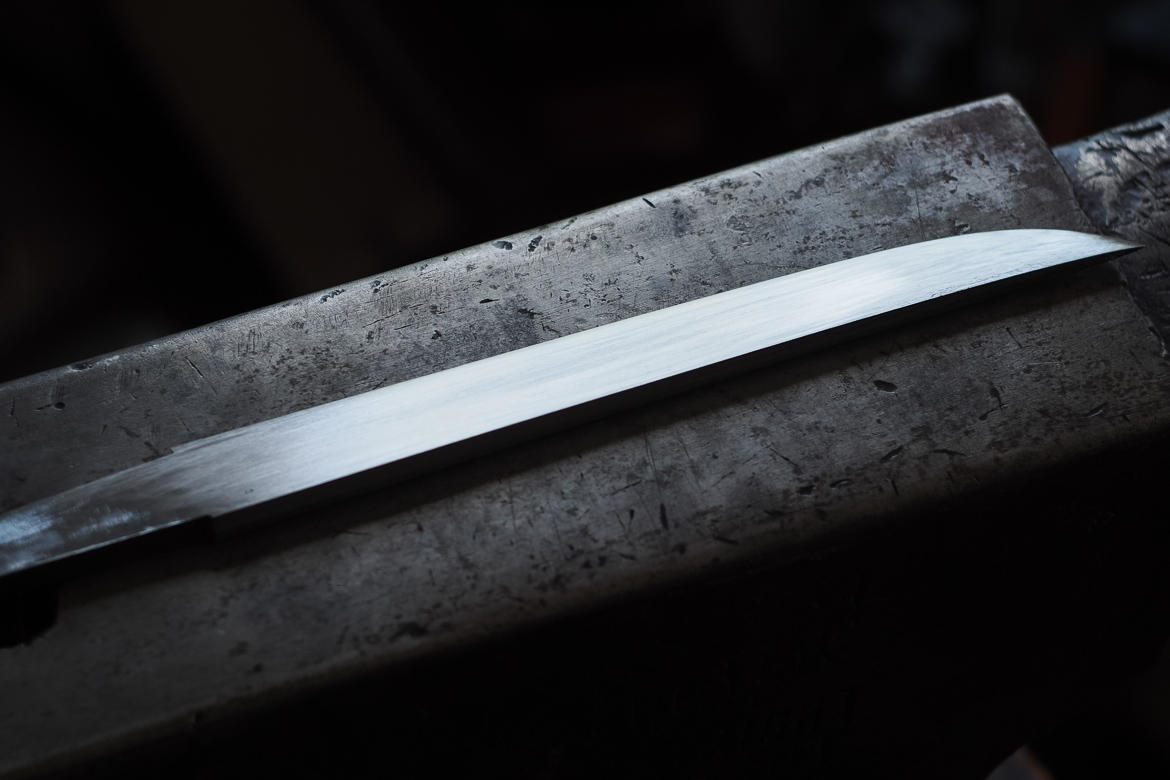How a Knife is Made
Once an appropriate piece of steel is identified, a knife is first shaped by a hammer, then by files and scrapers, then heat treated, then polished with files and stones, and given a handle, fittings, and a scabbard. Though there are many nuanced steps to each of these stages, the divisions presented below portray the clearest distinctions between the different types of work that go into creating a handmade knife from start to finish.

Raw Material
Steel in its most basic form is iron with a small percentage of carbon. Most items made of steel contain less than half a percent of carbon and cannot be made into blades that take and hold a good edge. If there is more than 2% the material is called cast iron, is brittle, and crumbles under the hammer. The best steel for cutting tools usually contains between 0.5% to 1.2% carbon.
Materials like harrow teeth, large circular saw blades or bandsaw blades, files, leaf springs, and chisels are often dependable sources of high carbon steel.
To assess the suitability of steel for making blades, several tests can be carried out in the blacksmith shop. One involves grinding the steel on a wheel and observing the colour and character of the sparks, another is to harden a small piece and break it, observing the colour, grain size, and character of the break, others involve file testing for hardness, or heat treating a test blade and subjecting it to stress tests like bending and chopping.

Forging & Annealing
In the first stage, the steel is heated to a red-orange heat in a charcoal forge and shaped with a hammer. Depending on the dimensions of the original piece, this may take many repeated trips between the fire and anvil. To help with shaping, a tapered rectangular bar called sunobe is forged first before forming the angled surfaces for the blade. After the forging is complete, the steel is heated again and allowed to cool as slowly as possible in order to leave it soft enough to cut with a file.

Profiling & Shaping
When the steel has cooled entirely, a file, a diamond stone, and sometimes a steel scraper are used to outline the blade shape and clean up all surfaces. This stage brings the steel to within a millimetre or two of its final shape at the edge.

Hardening & Tempering
The hardening stage is the most difficult for a piece of steel to endure. If it survives without cracking or warping, it will make the transition from a piece of steel to a live blade.
A special mixture of water, clay, ash, stone, and charcoal dust is applied to the back of the blade to act as a heat mask when the blade is hardened. The areas of the blade that are wrapped in clay cool slower than the areas without. This split second difference allows the cutting edge to be harder and sharper while the body of the blade retains more toughness and springiness.
The dried clay-coated blade is carefully heated until it is no longer magnetic and then when it reaches the correct low orange-red colour, it is plunged into very warm water to cool. It is at this moment when the steel will either become a blade or succumb to the stress and become scrap metal. Depending on the steel, varying amounts of the hardness will need to be removed by heating slightly again over the hot coals to add more resilience.

Polishing & Finishing
This is arguably the most labour intensive stage of the process. At this point the steel is too hard for files or scrapers and must be given its final shape with stones and then polished with successively finer stones and water. Each time the blade is polished with a finer finish than the step before, and all the marks from the previous step must be removed before going on to the next. This takes patience and many hours of hand labour.

Handle & Fittings
A guard and pommel and other knife furniture are created from copper, iron, brass, horn, or bone. Each piece is shaped and smoothed using several tools. The handle is shaped and fitted to the tang using chisels, knives, and planes. The goal is to create a tight, clean fit between the wood and steel and all other parts. Unlike metal, wood cannot be bent or stretched if too much is cut away so careful work and frequent checking are necessary. A single bamboo peg holds the tang of the knife securely in the handle and all the fittings along with it.

Scabbard
The sheath is usually made from wood and finished with 100% tung oil or natural urushi lacqer. Vegetable tanned leather or buckskin is wet formed, cut to shape, and hand stitched to create a custom fit sheath and often includes retaining straps and belt loops. A wooden sheath is made by carefully sawing a selected block of wood in half and carving out the recess for the blade. As with the handle, this process must proceed with great caution to avoid cutting too much away. The halves are rejoined using rice glue, wood glue, or metal rivets and final shaping is done with planes and chisels. The sheath may be finished with a wrapping or a wax finish may be applied to keep the wood bright and smooth.

Read more about making this knife: Process: Making the Tsukimi Tanto
See the finished work: Tsukimi Tanto
See more hand forged tanto: Featured Work Archive


